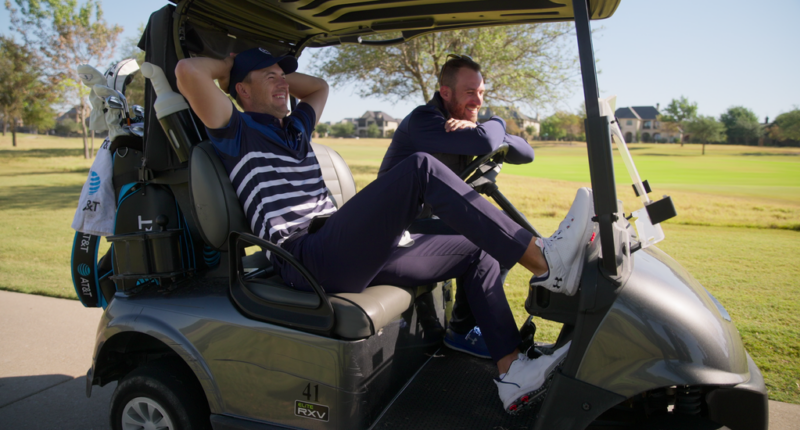
By the fourth season of Netflix’s documentary series about Formula 1, “Drive to Survive,” the streaming company had plenty of evidence that it was onto something: Ratings and attendance for Grand Prix events, as well as merchandise sales, were surging.
So Netflix executives began discussions with the show’s producers: What other sports are out there?
“It really showed us that the ceiling was much higher than we might have thought,” said Brandon Riegg, the Netflix vice president of nonfiction series.
On Wednesday, Netflix’s latest sports documentary series, “Full Swing,” which focuses on men’s professional golf, will become available, just weeks after its tennis-focused series, “Break Point,” debuted.
For years, Netflix executives have resisted paying for the rights to carry live sports, even as streaming rivals like Amazon, Apple and YouTube have chased them aggressively. Netflix is instead pursuing a more modest strategy, building out a sports lineup focused on telling the stories beyond the leaderboard — and at a considerably smaller cost than for licensing rights to live games.
It is not clear if “Full Swing” or “Break Point” will come close to matching the impact of “Drive to Survive.” Ratings for the Australian Open men’s final, which took place a little more than two weeks after “Break Point” was released, hit a decade low.
Nevertheless, Netflix executives are confident in focusing on leagues that haven’t “really been covered in an exhaustive way compared to some other sports,” Mr. Riegg said. And professional golf and tennis are bursting with enthusiasm at the prospect of gaining access to Netflix’s 230 million paying subscribers, and are hopeful of the kind of bump that Formula 1 received from “Drive to Survive.”
“It turned people not into just ‘What is F1?’ but it turned people into actual die-hard fans in the U.S. that would turn it on Sunday morning — it’s on at like 5 a.m.,” said Collin Morikawa, the 26-year-old golfer who has won the British Open and the P.G.A. Championship, in an interview at a putting green in Arizona.
For some time, the PGA Tour has been looking to do a documentary series to help raise the sport’s profile. In June 2017, tour executives met with Netflix officials to discuss the possibility of a series. Netflix passed at the time because it had not yet figured out its sports strategy and the concept was “too unbaked,” Mr. Riegg recalled.
The Race to Rule Streaming TV
But by the next year, with the debuts of series like “Nailed It!” and “Queer Eye,” Netflix began investing heavily in unscripted television. A documentary about Aaron Hernandez, a football player who was convicted of murder, was a hit in early 2020, and “Drive to Survive” became a hit shortly thereafter.
For years, live sports rights have been a topic of near constant debate in Netflix leadership meetings. But even as executives have considered it, they have always settled in the same place: The company’s money is better spent elsewhere.
“We’re not in the business of live sports rights. We’re not in the business of renting,” Mr. Riegg said.
Netflix is open to doing documentary series on more popular American sports like football or basketball, Mr. Riegg said. But it would need the access, and the full editorial control, that Formula 1, golf and tennis have given it.
“Whether it’s live sports or documentaries or shows or fictional shows about sports, sports resonate with almost everybody in some way, so Netflix knows that,” said Chris Wandell, a PGA Tour executive who was central to the negotiations about the documentary series.
Not long after Netflix’s cameras began rolling, men’s professional golf turned into a soap opera, with Saudi Arabia’s sovereign wealth fund investing billions of dollars into the rival LIV Golf, a league that drew the defections of several major PGA Tour players, including Phil Mickelson, Brooks Koepka and Dustin Johnson. Over the last year, there have been lawsuits, as well as heated debates over ethics, greed, power and human rights.
Like “Drive to Survive,” the series focuses on behind-the-scenes story lines, and producers gained access to players’ locker rooms, homes and private jets. Stars like Mr. Koepka, Mr. Morikawa and Jordan Spieth are featured, as are lower-profile players like Joel Dahmen.
“As soon as they said all of the people from ‘Drive to Survive’ are coming over and are going to do this, that’s immediate credibility,” Mr. Dahmen said.
Players and executives said they welcomed an outlet that did not broadcast the sport.
“Netflix’s track record is pretty good, and it’s the best in this space,” said Martin Slumbers, the chief executive of the R&A, the governing body that organizes the British Open. “What is good about them is they are truly a global platform, and I think if we had gone for a streaming that was more just U.S., U.K., I don’t think we would have had the impact, and I’m not sure I would be as excited about it.”
The series sets out to present golf differently from the “somewhat staid coverage on CBS,” Mr. Riegg said, referring to a longtime golf broadcaster.
“People think golf is a gentlemen’s sport,” Mr. Koepka said in the beginning of the second episode. To disabuse such a notion, he added that competitors “want to step on my throat, and I want to step on theirs.”
If some die-hard Formula 1 and tennis fans grouse that the Netflix documentaries better serve newbies, “Full Swing” can be, at times, similarly elementary. The opening episode explains basic scoring rules, including what a bogey is.
“You know how hard it is to explain ‘par’ in one sentence?” said Chad Mumm, the chief creative officer at Vox Media Studios, which, along with Box to Box, produced “Full Swing.” (Box to Box also produced “Drive to Survive” and “Break Point.”)
Netflix has not yet committed to a second season of “Full Swing.” But at last week’s Phoenix Open at T.P.C. Scottsdale, “Full Swing” camera crews were conspicuous.
Even if it does not reach the heights of “Drive to Survive,” many players feel that “Full Swing” can only be a boost to the tour.
“If we can just get a fraction of that,” Mr. Morikawa said, “we’re doing pretty well.”
Source: | This article originally belongs to Nytimes.com









